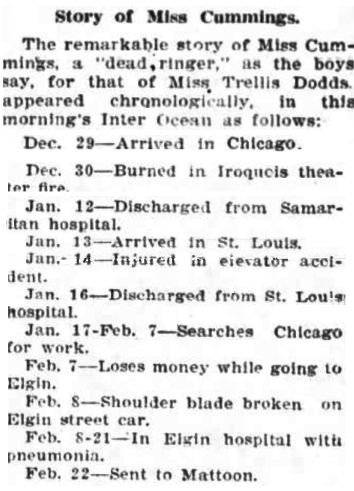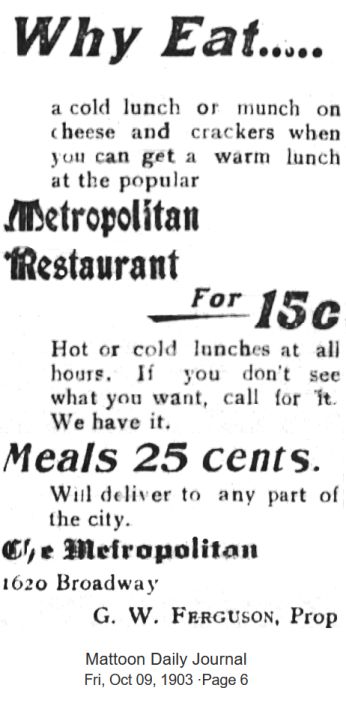|
Two newspapers in the spring of 1904
enjoyed recounting the implausible
stories of a young woman who devised an economical method of travel.
Leveraging a tearful tale of mishaps,
sometimes calling herself Edna Cummings, sometimes Trellis Dodd, she toured the midwest,
relying on kindness from strangers. When hungry and in need of lodging, she staged
a minor injury in circumstances sure to bring
offers of assistance, slipping and falling her way from town to town.
A busy girl

She first appeared in newspapers in mid February, 1904,
two months after the Iroquois Theater fire, reportedly seeking a former
classmate, Mrs. Meiers,▼1 and old friend, George W. Ferguson, in Mattoon, Illinois.
She said she'd been born and raised in Dallas but had last lived in New Orleans, had a sister, two brothers, Harry and
George, her twin, three half sisters, and an uncle named Horace Wilcox who was a wealthy planter
with a plantation between New Orleans and Baton Rouge. Coincidentally the sister's name
was Edna.
Edna-Trellis interwove much-publicized details of the Iroquois fire with an improbable story of her personal
involvement. She claimed to have chatted with the Eldridge brothers moments before
the first broke out, then escaped from the Iroquois with burns serious enough to require
a two-week hospital stay — but first popped over to nurse victims at Thompson's
Diner. Such was the competition for news about Iroquois victims that reporters
were camped out at hotels, hospitals and funeral homes. The likelihood of Edna's dramatic story escaping the attention of Chicago newspapers
was zero. With Chicago
newspapers publishing daily updates on hospitalized victims, such an item would have
spread from the hospital to a newspaper within forty-eight hours. Edna counted on
people outside Chicago not studying newspaper stories enough to know that none of the
handful of Iroquois victims who lingered in hospitals was named Dodds or Cummings.▼2
Until her ghost appears to tell me otherwise, I'm betting that Edna-Trellis read about
the fire and added it to her story because it contributed to the victim narrative that
was her bread and butter.
|

|

Caveat
Mattoon, Illinois is midway between Indianapolis, Indiana and St. Louis,
Missouri. In 1904 its population was around ten thousand. The only thing
that lends credibility to Edna's claims is that George Washington Ferguson (1877–1961)
— until December 1903 owner of the Metropolitan Restaurant in Mattoon, that he'd owned
for three months — was cousin to the Eldridge brothers. His late mother,
Francis "Fannie" Hart Ferguson (1837–1902), was the sister of their mother, Mary Hart
Eldridge (1852–1922). I did not find newspaper mention of the Ferguson/Eldridge
relationship but there were stories published about the parents' agony over their
sons and the Iroquois Theater fire, and townspeople would have been quick to talk about
the family's plight to a stranger who said she'd been at the Iroquois. I can
easily imagine a pretty young woman striking up a conversation at the train station and
coming away with usable information.
|
